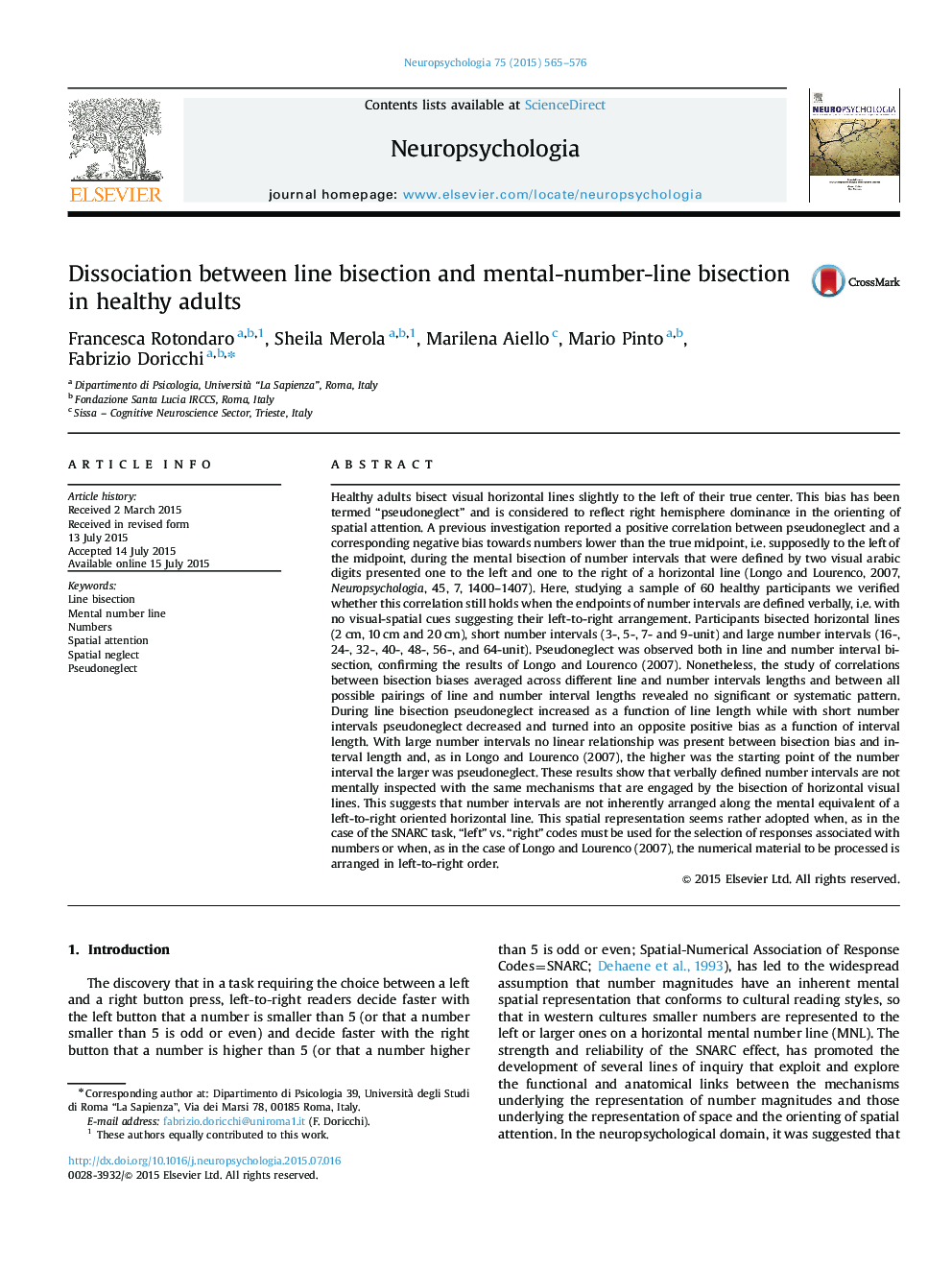| کد مقاله | کد نشریه | سال انتشار | مقاله انگلیسی | نسخه تمام متن |
|---|---|---|---|---|
| 7320224 | 1475578 | 2015 | 12 صفحه PDF | دانلود رایگان |
عنوان انگلیسی مقاله ISI
Dissociation between line bisection and mental-number-line bisection in healthy adults
ترجمه فارسی عنوان
تفکیک بین خطوط بیضه و تعداد خطوط خط روانی در بزرگسالان سالم
دانلود مقاله + سفارش ترجمه
دانلود مقاله ISI انگلیسی
رایگان برای ایرانیان
کلمات کلیدی
موضوعات مرتبط
علوم زیستی و بیوفناوری
علم عصب شناسی
علوم اعصاب رفتاری
چکیده انگلیسی
Healthy adults bisect visual horizontal lines slightly to the left of their true center. This bias has been termed “pseudoneglect” and is considered to reflect right hemisphere dominance in the orienting of spatial attention. A previous investigation reported a positive correlation between pseudoneglect and a corresponding negative bias towards numbers lower than the true midpoint, i.e. supposedly to the left of the midpoint, during the mental bisection of number intervals that were defined by two visual arabic digits presented one to the left and one to the right of a horizontal line (Longo and Lourenco, 2007, Neuropsychologia, 45, 7, 1400-1407). Here, studying a sample of 60 healthy participants we verified whether this correlation still holds when the endpoints of number intervals are defined verbally, i.e. with no visual-spatial cues suggesting their left-to-right arrangement. Participants bisected horizontal lines (2 cm, 10 cm and 20 cm), short number intervals (3-, 5-, 7- and 9-unit) and large number intervals (16-, 24-, 32-, 40-, 48-, 56-, and 64-unit). Pseudoneglect was observed both in line and number interval bisection, confirming the results of Longo and Lourenco (2007). Nonetheless, the study of correlations between bisection biases averaged across different line and number intervals lengths and between all possible pairings of line and number interval lengths revealed no significant or systematic pattern. During line bisection pseudoneglect increased as a function of line length while with short number intervals pseudoneglect decreased and turned into an opposite positive bias as a function of interval length. With large number intervals no linear relationship was present between bisection bias and interval length and, as in Longo and Lourenco (2007), the higher was the starting point of the number interval the larger was pseudoneglect. These results show that verbally defined number intervals are not mentally inspected with the same mechanisms that are engaged by the bisection of horizontal visual lines. This suggests that number intervals are not inherently arranged along the mental equivalent of a left-to-right oriented horizontal line. This spatial representation seems rather adopted when, as in the case of the SNARC task, “left” vs. “right” codes must be used for the selection of responses associated with numbers or when, as in the case of Longo and Lourenco (2007), the numerical material to be processed is arranged in left-to-right order.
ناشر
Database: Elsevier - ScienceDirect (ساینس دایرکت)
Journal: Neuropsychologia - Volume 75, August 2015, Pages 565-576
Journal: Neuropsychologia - Volume 75, August 2015, Pages 565-576
نویسندگان
Francesca Rotondaro, Sheila Merola, Marilena Aiello, Mario Pinto, Fabrizio Doricchi,
